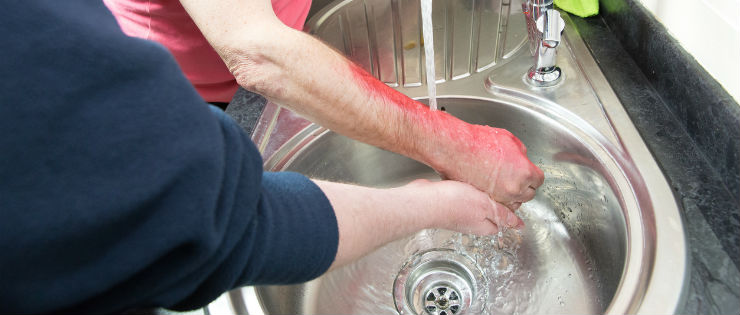
There are few things more painful than a burn. You know that even the slightest brush against the oven tray or a few drops of boiling water can result in hours of pain. Burns are not only uncomfortable; they are at high risk of becoming infected. When a burn covers a large part of the body or is full thickness, they can be life-threatening and cause physical and emotional scars. If treated right, you can reduce the effects of a serious burn.
Burns on Children
Young children are at greater risk of burns than adults. They don’t understand the dangers a hot cup of coffee pose or that the oven door is hot to touch. The effect of a burn on children is made worse because their skin is much thinner than adults. Also, with less surface area on their body, a small burn on an adult can be a large percentage on a baby. The size of a burn can be assessed using a patient’s hand. Our hand is roughly 1% of our body.
First Aid Before an Ambulance Arrives
- Remove any loose clothing near a burn however if the clothing is stuck to the skin or blisters have formed, don’t attempt to remove the clothing.
- Run cold water over the burn for at least 10 minutes
- In the case of a serious burn, call an ambulance and continue to run the cold water over the burn area. Keep the rest of the patient warm.
First Aid Before Seeking Medical Attention
- Remove any loose clothing near the burn site.
- Run cold water over the burn for 10 minutes.
- Allow a burn to cool for at least 15 minutes.
- Use a sterile, non-fluffy dressing to cover a burn and reduce the chance of infection. Cling wrap can be used just make sure you have a clean piece by unrolling a couple of turns and discarding. Loosely place the cling wrap over the burn before seeing a doctor.
It is important to seek medical attention for any burns on young children. Adults with a burn that is larger than several centimetres in diameter or the burn is on the face, hands, feet or genitalia should see a doctor. All second degree (partial thickness) and third degree (full thickness) burns should also be seen by a doctor for treatment.
HIF Ambulance Cover
We hope you will never need to call an ambulance, but if you do you will want the fees covered. Check out HIF’s Ambulance Cover for details of benefits in your state.